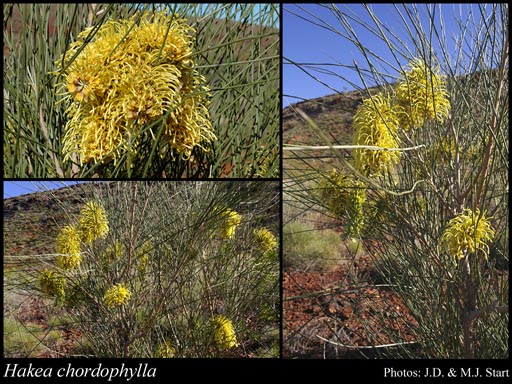- Reference
- Hooker's J.Bot.Kew Gard.Misc. 9:23 (1857)
- Conservation Code
- Not threatened
- Naturalised Status
- Native to Western Australia
- Name Status
- Current
Shrub or tree, 1.5-5(-8) m high. Fl. cream-yellow/red, Jun to Sep. Red/brown sand, rocky or stony soil. Sandplains.

Scientific Description
Trees or Shrubs, 1.5-7.5 m high; branchlets glabrous or hairy. Leaves alternate, 150-255(-420) mm long, 2-3 mm wide, glabrous; lamina terete, entire. Inflorescences axillary, yellow; pedicels 6-10 mm long. Perianth 6-8 mm long, hairy; ovary glabrous; pistil 25-29 mm long, pollen presenter oblique, style glabrous. Follicles 26-40 mm long, 13-20 mm wide, corky tetrahedral projections (on external surfaces of fruit) absent; seed 25-35 mm long (including wing), 8-13 mm wide, the wing discontinuous, marginal, extending down one lateral side only. Flowers in June, July, August or September. Occurs in the Northern (N) or Eremaean (ER) Botanical Province(s), in the Great Sandy Desert (GSD), Pilbara (PIL), Little Sandy Desert (LSD), Central Ranges (CR), Northern Kimberley (NK), Dampierland (DL) or Ord-Victoria Plains (OVP) IBRA subregion(s).
Distribution
- IBRA Regions
- Central Kimberley, Central Ranges, Dampierland, Gibson Desert, Great Sandy Desert, Little Sandy Desert, Northern Kimberley, Ord Victoria Plain, Pilbara.
- IBRA Subregions
- Chichester, Fitzroy Trough, Hamersley, Lateritic Plain, Mann-Musgrave Block, McLarty, Mitchell, Mount Eliza, Pindanland, Purnululu, Rudall, South Kimberley Interzone.
- Local Government Areas (LGAs)
- Ashburton, Broome, Derby-West Kimberley, East Pilbara, Halls Creek, Ngaanyatjarraku, Wyndham-East Kimberley.